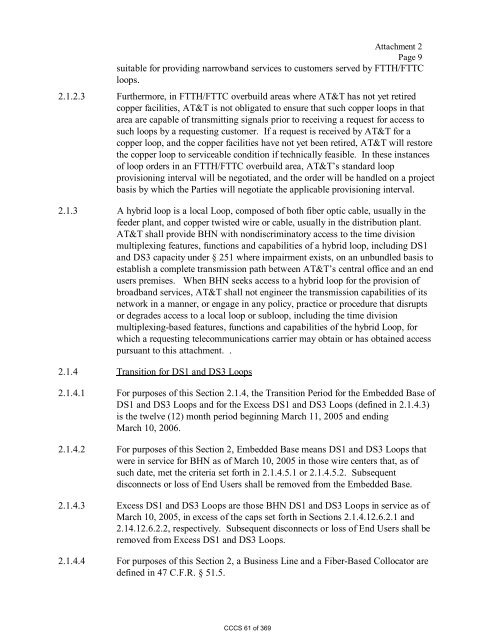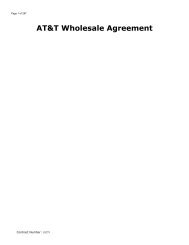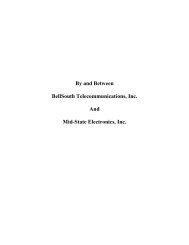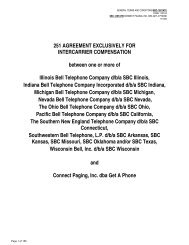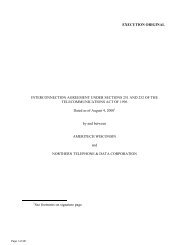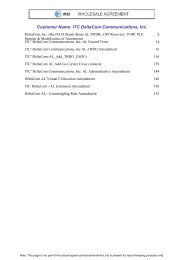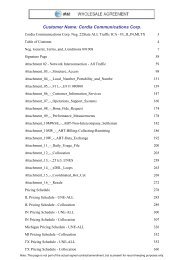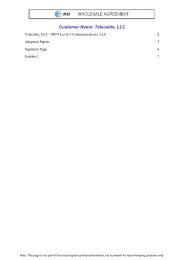- Page 1 and 2:
BELL BELLSOUTH BELL BELL BELL SOUTH
- Page 3 and 4:
General Terms and Conditions Versio
- Page 5 and 6:
Version May 27, 2002 AGREEMENT GENE
- Page 7 and 8:
Version May 27, 2002 Page 3 certifi
- Page 9 and 10: Version May 27, 2002 Page 5 deliver
- Page 11 and 12: Version May 27, 2002 Page 7 6.5 Dis
- Page 13 and 14: Version May 27, 2002 Page 9 proprie
- Page 15 and 16: Version May 27, 2002 Page 11 10.3.3
- Page 17 and 18: Version May 27, 2002 interest, pena
- Page 19 and 20: 16. Waivers Version May 27, 2002 Pa
- Page 21 and 22: Version May 27, 2002 Page 17 No rul
- Page 23 and 24: 31. Survival Version May 27, 2002 P
- Page 25 and 26: CCCS 25 of 369
- Page 27 and 28: Version 4Q01 12/01/01 Table of Cont
- Page 29 and 30: 3. General Provisions Version 4Q01
- Page 31 and 32: Version 4Q01 12/01/01 Attachment 1
- Page 33 and 34: Version 4Q01 12/01/01 Attachment 1
- Page 35 and 36: Version 4Q01 12/01/01 Attachment 1
- Page 37 and 38: 8.4 Branding for Operator Call Proc
- Page 39 and 40: 9.2 AT&T will provide LIDB Storage
- Page 41 and 42: Type of Service Version 4Q01 12/01/
- Page 43 and 44: Attachment 1 Page 18 Exhibit B cont
- Page 45 and 46: Attachment 1 Page 20 Exhibit B B. S
- Page 47 and 48: Version 4Q01 12/01/01 - Operator Se
- Page 49 and 50: Version 4Q01 12/01/01 Enhanced Opti
- Page 51 and 52: Version 4Q01 12/01/01 Attachment 1
- Page 53 and 54: Attachment 2 Network Elements and O
- Page 55 and 56: ACCESS TO NETWORK ELEMENTS AND OTHE
- Page 57 and 58: Attachment 2 Page 5 any dispute bet
- Page 59: Attachment 2 Page 7 1.14 If BHN rep
- Page 63 and 64: Attachment 2 Page 11 2.1.4.11.2 For
- Page 65 and 66: Attachment 2 Page 13 2.1.9.1.1 In t
- Page 67 and 68: Attachment 2 Page 15 2.3.2 Arrangem
- Page 69 and 70: Attachment 2 Page 17 on a time and
- Page 71 and 72: Attachment 2 Page 19 individual End
- Page 73 and 74: Attachment 2 Page 21 2.6.1.1 AT&T s
- Page 75 and 76: 3.0 Unbundled Network Element Combi
- Page 77 and 78: Attachment 2 Page 25 3.4.4.2.5 5) E
- Page 79 and 80: Attachment 2 Page 27 4.2.6.3 Notwit
- Page 81 and 82: Attachment 2 Page 29 identified and
- Page 83 and 84: Attachment 2 Page 31 The COCI must
- Page 85 and 86: Attachment 2 Page 33 4.9.2.4.1 Dark
- Page 87 and 88: Attachment 2 Page 35 transitioned,
- Page 89 and 90: UNBUNDLED NETWORK ELEMENTS - Alabam
- Page 91 and 92: UNBUNDLED NETWORK ELEMENTS - Alabam
- Page 93 and 94: UNBUNDLED NETWORK ELEMENTS - Alabam
- Page 95 and 96: UNBUNDLED NETWORK ELEMENTS - Alabam
- Page 97 and 98: UNBUNDLED NETWORK ELEMENTS - Alabam
- Page 99 and 100: UNBUNDLED NETWORK ELEMENTS - Alabam
- Page 101 and 102: UNBUNDLED NETWORK ELEMENTS - Alabam
- Page 103 and 104: TABLE OF CONTENTS Attachment 3 Page
- Page 105 and 106: Attachment 3 Page 4 proposed locati
- Page 107 and 108: Attachment 3 Page 6 4.1 AT&T and BH
- Page 109 and 110: Attachment 3 Page 8 that have a Mee
- Page 111 and 112:
Attachment 3 Page 10 4.10.1.5.3 Com
- Page 113 and 114:
Attachment 3 Page 12 IXCs, and GR-3
- Page 115 and 116:
Attachment 3 Page 14 5.7.1.1 At a m
- Page 117 and 118:
Attachment 3 Page 16 LATA. ISP-boun
- Page 119 and 120:
Attachment 3 Page 18 notify the ori
- Page 121 and 122:
Attachment 3 Page 20 7.5.7 Any clai
- Page 123 and 124:
Version 4Q01: 12/01/01 BST EO 1 - w
- Page 125 and 126:
Version 4Q01: 12/01/01 BST EO 2 - w
- Page 127 and 128:
Version 4Q01: 12/01/01 DEFINITIONS
- Page 129 and 130:
ATTACHMENT 3 PAGE 28 transmission p
- Page 131 and 132:
Version 4Q01: 12/01/01 Attachment 4
- Page 133 and 134:
Attachment 4-Central Office Page 3
- Page 135 and 136:
Version 4Q01: 12/01/01 Attachment 4
- Page 137 and 138:
Attachment 4-Central Office Page 7
- Page 139 and 140:
Version 4Q01: 12/01/01 Attachment 4
- Page 141 and 142:
Version 4Q01: 12/01/01 Attachment 4
- Page 143 and 144:
Version 4Q01: 12/01/01 Attachment 4
- Page 145 and 146:
Version 4Q01: 12/01/01 Attachment 4
- Page 147 and 148:
Attachment 4-Central Office Page 17
- Page 149 and 150:
7.1 Construction and Provisioning I
- Page 151 and 152:
Version 4Q01: 12/01/01 Attachment 4
- Page 153 and 154:
Version 4Q01: 12/01/01 Attachment 4
- Page 155 and 156:
Version 4Q01: 12/01/01 Attachment 4
- Page 157 and 158:
Version 4Q01: 12/01/01 Attachment 4
- Page 159 and 160:
Version 4Q01: 12/01/01 Attachment 4
- Page 161 and 162:
Version 4Q01: 12/01/01 Attachment 4
- Page 163 and 164:
Version 4Q01: 12/01/01 Attachment 4
- Page 165 and 166:
12. Destruction of Collocation Spac
- Page 167 and 168:
Version 4Q01: 12/01/01 ENVIRONMENTA
- Page 169 and 170:
ENVIRONMENTAL CATEGORIES Disposal o
- Page 171 and 172:
immediate significant damage to the
- Page 173 and 174:
COLLOCATION - Alabama CATEGORY RATE
- Page 175 and 176:
COLLOCATION - Alabama CATEGORY RATE
- Page 177 and 178:
COLLOCATION - Alabama CATEGORY RATE
- Page 179 and 180:
Version 4Q01: 12/01/01 TABLE OF CON
- Page 181 and 182:
Version 4Q01: 12/01/01 Attachment 5
- Page 183 and 184:
Version 3Q03: 11/05/2003 Attachment
- Page 185 and 186:
Version 3Q03: 11/05/2003 EXHIBIT 3
- Page 187 and 188:
EXHIBIT 3 Attachment 6 2.1.5 Billin
- Page 189 and 190:
Version 3Q03: 11/05/2003 EXHIBIT 3
- Page 191 and 192:
Version: 4Q04 Standard ICA 12/09/04
- Page 193 and 194:
Version: 4Q04 Standard ICA 12/09/04
- Page 195 and 196:
Version: 4Q04 Standard ICA 12/09/04
- Page 197 and 198:
Version: 4Q04 Standard ICA 12/09/04
- Page 199 and 200:
Version: 4Q04 Standard ICA 12/09/04
- Page 201 and 202:
Version: 4Q04 Standard ICA 12/09/04
- Page 203 and 204:
Version: 4Q04 Standard ICA 12/09/04
- Page 205 and 206:
Version 4Q01: 12/01/01 Rights-of-Wa
- Page 207 and 208:
Version 2Q02: 05/31/02 PERFORMANCE
- Page 209 and 210:
Region Performance Metrics Introduc
- Page 211 and 212:
Region Performance Metrics Introduc
- Page 213 and 214:
Region Performance Metrics Introduc
- Page 215 and 216:
Region Performance Metrics OSS Admi
- Page 217 and 218:
Region Performance Metrics OSS acce
- Page 219 and 220:
Region Performance Metrics OSS OSS
- Page 221 and 222:
Region Performance Metrics OSS OSS
- Page 223 and 224:
Region Performance Metrics OSS Lega
- Page 225 and 226:
Region Performance Metrics OSS Repo
- Page 227 and 228:
Region Performance Metrics OSS Resp
- Page 229 and 230:
Region Performance Metrics Ordering
- Page 231 and 232:
Region Performance Metrics Ordering
- Page 233 and 234:
Region Performance Metrics Ordering
- Page 235 and 236:
Region Performance Metrics Ordering
- Page 237 and 238:
Region Performance Metrics Ordering
- Page 239 and 240:
Region Performance Metrics Ordering
- Page 241 and 242:
Region Performance Metrics Ordering
- Page 243 and 244:
Region Performance Metrics Ordering
- Page 245 and 246:
Region Performance Metrics Ordering
- Page 247 and 248:
Region Performance Metrics Ordering
- Page 249 and 250:
Region Performance Metrics Ordering
- Page 251 and 252:
Region Performance Metrics Ordering
- Page 253 and 254:
Region Performance Metrics Ordering
- Page 255 and 256:
Region Performance Metrics Ordering
- Page 257 and 258:
Region Performance Metrics Ordering
- Page 259 and 260:
Region Performance Metrics Ordering
- Page 261 and 262:
Region Performance Metrics Ordering
- Page 263 and 264:
Region Performance Metrics Provisio
- Page 265 and 266:
Region Performance Metrics Provisio
- Page 267 and 268:
Region Performance Metrics Provisio
- Page 269 and 270:
Region Performance Metrics Provisio
- Page 271 and 272:
Region Performance Metrics Provisio
- Page 273 and 274:
Region Performance Metrics Provisio
- Page 275 and 276:
Region Performance Metrics Provisio
- Page 277 and 278:
Region Performance Metrics Provisio
- Page 279 and 280:
Region Performance Metrics Provisio
- Page 281 and 282:
Region Performance Metrics Provisio
- Page 283 and 284:
Region Performance Metrics Provisio
- Page 285 and 286:
Region Performance Metrics Provisio
- Page 287 and 288:
Region Performance Metrics Provisio
- Page 289 and 290:
Region Performance Metrics Provisio
- Page 291 and 292:
Region Performance Metrics Provisio
- Page 293 and 294:
Region Performance Metrics Provisio
- Page 295 and 296:
Region Performance Metrics Provisio
- Page 297 and 298:
Region Performance Metrics Provisio
- Page 299 and 300:
Region Performance Metrics M&R Sect
- Page 301 and 302:
Region Performance Metrics M&R M&R-
- Page 303 and 304:
Region Performance Metrics M&R M&R-
- Page 305 and 306:
Region Performance Metrics M&R M&R-
- Page 307 and 308:
Region Performance Metrics M&R M&R-
- Page 309 and 310:
Region Performance Metrics M&R M&R-
- Page 311 and 312:
Region Performance Metrics Billing
- Page 313 and 314:
Region Performance Metrics Billing
- Page 315 and 316:
Region Performance Metrics Billing
- Page 317 and 318:
Region Performance Metrics Billing
- Page 319 and 320:
Region Performance Metrics Billing
- Page 321 and 322:
Region Performance Metrics OSDA Sec
- Page 323 and 324:
Region Performance Metrics OSDA DA-
- Page 325 and 326:
Region Performance Metrics DUI Sect
- Page 327 and 328:
Region Performance Metrics DUI D-2:
- Page 329 and 330:
Region Performance Metrics DUI D-3:
- Page 331 and 332:
Region Performance Metrics E911 Sec
- Page 333 and 334:
Region Performance Metrics E911 E-3
- Page 335 and 336:
Region Performance Metrics TGP Aggr
- Page 337 and 338:
Region Performance Metrics TGP Calc
- Page 339 and 340:
Region Performance Metrics Change M
- Page 341 and 342:
Region Performance Metrics Change M
- Page 343 and 344:
Region Performance Metrics Change M
- Page 345 and 346:
Region Performance Metrics Change M
- Page 347 and 348:
Region Performance Metrics BFR BFR-
- Page 349 and 350:
Region Performance Metrics Glossary
- Page 351 and 352:
Region Performance Metrics Glossary
- Page 353 and 354:
Region Performance Metrics Glossary
- Page 355 and 356:
Region Performance Metrics Glossary
- Page 357 and 358:
Region Performance Metrics Glossary
- Page 359 and 360:
CONTENTS Version 4Q01: 12/01/01 Att
- Page 361 and 362:
3.1 SITE CONTROL Version 4Q01: 12/0
- Page 363 and 364:
Version 4Q01: 12/01/01 Attachment 1
- Page 365 and 366:
Version 4Q01: 12/01/01 Attachment 1
- Page 367 and 368:
Version 4Q01: 12/01/01 Attachment 1
- Page 369:
Version 4Q01: 12/01/01 ATTACHMENT 1


